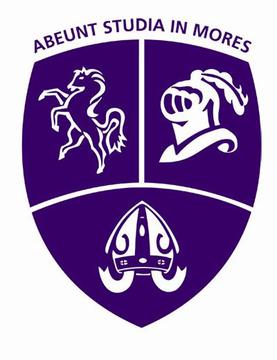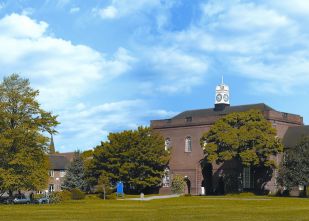
A grammar school is one of several different types of school in the history of education in the United Kingdom and other English-speaking countries, originally a school teaching Latin, but more recently an academically oriented secondary school.
The Tripartite System was the arrangement of state-funded secondary education between 1945 and the 1970s in England and Wales, and from 1947 to 2009 in Northern Ireland. It was an administrative implementation of the Education Act 1944 and the Education Act 1947.

Charles Anthony Raven Crosland was a British Labour Party politician and author. A social democrat on the right wing of the Labour Party, he was a prominent socialist intellectual. His influential book The Future of Socialism (1956) argued against many Marxist notions and the traditional Labour Party doctrine that expanding public ownership was essential to make socialism work, arguing instead for prioritising the end of poverty and improving public services. He offered positive alternatives to both the right wing and left wing of the Labour Party.

A comprehensive school is a secondary school for pupils aged 11–16 or 11–18, that does not select its intake on the basis of academic achievement or aptitude, in contrast to a selective school system where admission is restricted on the basis of selection criteria, usually academic performance. The term is commonly used in relation to England and Wales, where comprehensive schools were introduced as state schools on an experimental basis in the 1940s and became more widespread from 1965.
Local education authorities (LEAs) were defined in England and Wales as the local councils responsible for education within their jurisdictions. The term was introduced by the Education Act 1902 which transferred education powers from school boards to existing local councils.

A secondary modern school is a type of secondary school that existed throughout England, Wales and Northern Ireland from 1944 until the 1970s under the Tripartite System. Schools of this type continue in Northern Ireland, where they are usually referred to as secondary schools, and in areas of England, such as Buckinghamshire, Lincolnshire and Wirral,.

The Plowden Report is the unofficial name for the 1967 report of the Central Advisory Council For Education (England) into Primary education in England. The report, entitled Children and their Primary Schools, reviewed primary education in a wholesale fashion. The collation of the report took around 3 years. The Council was chaired by Bridget, Lady Plowden after whom the report is named.

Chislehurst and Sidcup Grammar School is a mixed-sex grammar school with academy status located in Hurst Road (A222), Sidcup in the London Borough of Bexley, England. It is located adjacent to Lamorbey Park, the Rose Bruford College drama school and Hurstmere School. Pupils at the school are divided into a series of six houses, known as Davies, Edlmann, Lester, Townshend, Williams, and Staff, while an annual school magazine, The Chronicle, is also produced by the students. The current head teacher, Nigel Walker, has held his position since 2009.
The administration of education policy in the Britain began in the 19th century. Official mandation of education began with the Elementary Education Act 1870 for England and Wales, and the Education (Scotland) Act 1872 for Scotland. Education policy has always been run separately for the component nations of Britain, and is now a devolved matter.
The raising of school leaving age is the term used by the United Kingdom government for changes of the age at which a child is allowed to leave compulsory education in England and Wales as specified under an Education Act.

Ysgol David Hughes is a bilingual secondary school on Anglesey, Wales. The school building was completed and opened in Menai Bridge in 1963 by Anglesey County Council which, ten years earlier, had become the first education authority in the UK to adopt non-selective comprehensive education.
In England, a partially selective school is one of a few dozen state-funded secondary schools that select a proportion of their intake by ability or aptitude, permitted as a continuation of arrangements that existed prior to 1997. Though treated together by current legislation, they are of two types: bilateral schools in remnants of the Tripartite System, and former grant-maintained schools that introduced partial selection in the 1990s. While technically classified as comprehensive schools, they occupy a middle ground between grammar schools and true comprehensives, and many of the arguments for and against grammar schools also apply to these schools. Although there are relatively few schools of this type, several of them score very highly in national performance tables, and are among the most over-subscribed schools in the country.
The history of education in England is documented from Saxon settlement of England, and the setting up of the first cathedral schools in 597 and 604.

A direct grant grammar school was a type of selective secondary school in the United Kingdom that existed between 1945 and 1976. One quarter of the places in these schools were directly funded by central government, while the remainder attracted fees, some paid by a Local Education Authority and some by the pupils' parents or guardians. On average, the schools received just over half of their income from the state.
Circular 10/70 was an attempt by Margaret Thatcher as Secretary of State for Education and Science in 1970 to reverse the effects of Circular 10/65 and Circular 10/66. The first circular requested LEAs to begin the process of conversion to fully comprehensive education, in line with the Labour government's wishes on the transition to a comprehensive national system. The second circular said that no funding would be given for new non-comprehensive schools. Circular 10/70 allowed LEAs to decide the future of Secondary Education in the area under their authority independently of the central government.

English state-funded schools, commonly known as state schools, provide education to pupils between the ages of 3 and 18 without charge. Approximately 93% of English schoolchildren attend such 24,000 schools. Since 2008 about 75% have attained "academy status", which essentially gives them a higher budget per pupil from the Department for Education.

A comprehensive school, or simply a comprehensive, typically describes a secondary school for pupils aged approximately 11–16 or 11–18, that does not select its intake on the basis of academic achievement or aptitude, in contrast to a selective school system where admission is restricted on the basis of selection criteria, usually academic performance. In England and Wales comprehensive schools were introduced as state schools on an experimental basis in the 1940s and became more widespread from 1965. They may be part of a local education authority or be a self governing academy or part of a multi-academy trust.

The Lakes School is a coeducational secondary school and sixth form located in Troutbeck Bridge, Windermere, in the English county of Cumbria.











